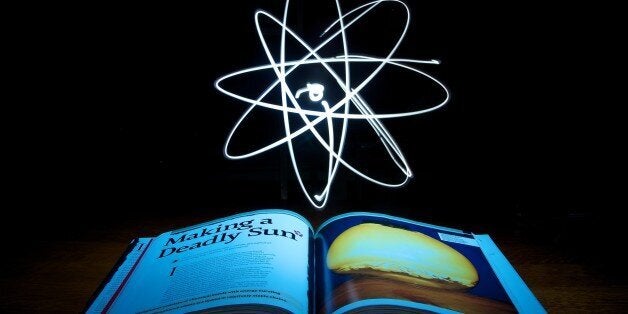
Sammy!) has been posting some great light painting shots (really, take a minute and browse through his photo stream; there's some really gorgeous stuff there). Light painting is something I always wanted to try my hand at, so I found new batteries for my old keychain LED flashlight (which I can turn on just by squeezing it) and looked for a subject. Drawing a glowing "atom" in the air above my copy of Theo Grey's Mad Science seemed like a great idea. I knew I wasn't going to get enough light from the flashlight on the book, so I set up a strobe to put some light on the pages, opened the book to an appropriate page, and tried doing some drawings on air. It was every bit as challenging as I expected to get something that looked decent.Of course, when I went to write this up to upload tonight, I see that Sammy also did a light painting surrounding a book for his shot today! Great minds and all that, I suppose.Nikon D7000 w/Nikkor 18-200mm @ 18mm, 15s @ Æ/8, ISO100. Single SB-700 on a stand, above on camera right, gelled blue, 85mm zoom, shooting through a 1/8" speed grid to keep the falloff tight to the book. Minor cropping in Aperture." data-caption="My initial thought for today was to try to take and post a half-underwater/half-above-water shot with the waterproof point-and-shoot I've rented to play with in the pond at camp this weekend. I did try a few shots, but the toy I intended to use as a prop had gone missing, so I didn't get quite what I wanted. On to Plan B.Over the last week or so one of my contacts (hi, Sammy!) has been posting some great light painting shots (really, take a minute and browse through his photo stream; there's some really gorgeous stuff there). Light painting is something I always wanted to try my hand at, so I found new batteries for my old keychain LED flashlight (which I can turn on just by squeezing it) and looked for a subject. Drawing a glowing "atom" in the air above my copy of Theo Grey's Mad Science seemed like a great idea. I knew I wasn't going to get enough light from the flashlight on the book, so I set up a strobe to put some light on the pages, opened the book to an appropriate page, and tried doing some drawings on air. It was every bit as challenging as I expected to get something that looked decent.Of course, when I went to write this up to upload tonight, I see that Sammy also did a light painting surrounding a book for his shot today! Great minds and all that, I suppose.Nikon D7000 w/Nikkor 18-200mm @ 18mm, 15s @ Æ/8, ISO100. Single SB-700 on a stand, above on camera right, gelled blue, 85mm zoom, shooting through a 1/8" speed grid to keep the falloff tight to the book. Minor cropping in Aperture." data-credit="djwtwo/Flickr">
Η ταυτόχρονη κβαντική τηλεμεταφορά δύο ιδιοτήτων ενός θεμελιώδους σωματιδίου, του φωτονίου, ανακηρύχθηκε «ανακάλυψη της χρονιάς» από το περιοδικό "Physics World" (Κόσμος της Φυσικής) του Ινστιτούτου Φυσικής με έδρα το Λονδίνο.
Το 1993 είχε για πρώτη φορά δειχθεί θεωρητικά ότι είναι δυνατή η τηλεμεταφορά μιας κβαντικής κατάστασης. Έκτοτε, όλο και περισσότερες ερευνητικές ομάδες ανακοινώνουν νέες επιτυχίες κβαντικής τηλεμεταφοράς σε ολοένα μεγαλύτερες αποστάσεις.
Όμως οι Γιαν-Γουέι Παν και Τσαογιάνγκ Λου του Πανεπιστημίου Επιστήμης και Τεχνολογίας της Κίνας, ήσαν οι πρώτοι που κατάφεραν να πετύχουν διπλή τηλεμεταφορά, τόσο της πόλωσης, όσο και της τροχιακής στροφορμής ενός φωτονίου σε ένα άλλο μακρινό φωτόνιο. Το επόμενο βήμα θα είναι η τριπλή -ή και η πολλαπλή-κβαντική τηλεμεταφορά. Ίσως κάποτε η ολική τηλεμεταφορά ενός ανθρώπου ή αντικειμένου αλά «Σταρ Τρεκ» περάσει απο την επιστημονική φαντασία στην πραγματικότητα.
Η κορυφαία δεκάδα ανακαλύψεων στη Φυσική το 2015 περιλαμβάνει:
- τη μέτρηση για πρώτη φορά της ακτινοβολίας κυκλότρου από ένα μόνο ηλεκτρόνιο
- την παρατήρηση για πρώτη φορά των φερμιονίων Weyl
- την πιο πειστική έως τώρα πειραματική επιβεβαίωση του φαινομένου της κβαντικής διεμπλοκής
- την πρώτη άμεση ανίχνευση φωτός από έναν εξωπλανήτη
- την ανακάλυψη δύο πενταπλών κουάρκ (pentaquarks) από τον επιταχυντή του CERN
- την ανακάλυψη του πρώτου υλικού (σουλφιδίου του υδρογόνου) που εμφανίζει «ζεστή» υπεραγωγιμότητα
- τη δημιουργία της πρώτης φορητής συσκευής μαγνητικής απεικόνισης (MRI)
- την κατασκευή του πρώτου φερμιονικού μικροσκοπίου και
- τη δημιουργία της πρώτης κβαντικής λογικής πύλης από πυρίτιο